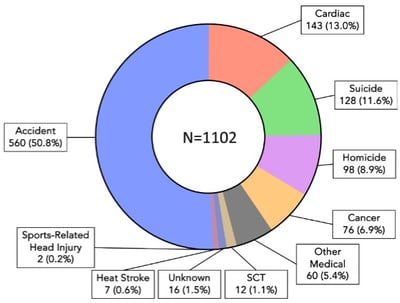Sudden Cardiac Death in NCAA Athletes: A Twenty-Year Study
 Sudden cardiac death (SCD) is a significant medical concern among young competitive athletes, particularly those in the National Collegiate Athletic Association (NCAA).
Sudden cardiac death (SCD) is a significant medical concern among young competitive athletes, particularly those in the National Collegiate Athletic Association (NCAA).
 We wanted to share results from a comprehensive 20-year study spanning from 2002 to 2022 that has shed new light on the incidence and nature of these tragic events, offering vital insights for future prevention and response strategies.
We wanted to share results from a comprehensive 20-year study spanning from 2002 to 2022 that has shed new light on the incidence and nature of these tragic events, offering vital insights for future prevention and response strategies.
The study, encompassing over 9 million athlete-years, identified 1102 deaths, of which 143 were due to SCD, making it the most common medical cause of death in this group. This research stands out for its meticulous approach, utilizing multiple independent data sources to overcome the limitations of previous studies, which often struggled with inconsistent methodologies and an incomplete understanding of the at-risk population.
One of the study's striking findings is the marked decrease in SCD incidence over the two decades, suggesting that efforts to improve pre-participation cardiovascular screening (PPCS) and emergency action plans are making an impact.
However, the reduction in SCD rates has not been uniform across all demographics. Male athletes, especially those in basketball and football, continue to exhibit a significantly higher risk compared to their female counterparts.
Specifically, Division I male basketball players, both White and Black, have an SCD incidence of over 1:2000 over a typical four-year college career. This disparity highlights the need for targeted screening and intervention strategies for these high-risk groups.
The study also delved into the causes of SCD, with autopsy-negative sudden unexplained death (AN-SUD) being the most common postmortem finding, followed by idiopathic left ventricular hypertrophy/possible cardiomyopathy and hypertrophic cardiomyopathy. This insight emphasizes the complexity of diagnosing and understanding SCD, as well as the potential value of postmortem genetic testing in providing clearer answers.
In terms of exertional status, SCD occurred during physical exertion in only half of the cases, with a significant variation depending on the underlying pathogenesis. Athletes with coronary artery anomalies and arrhythmogenic cardiomyopathy were most likely to experience exertional SCD.
Interestingly, the study found no cases of SCD attributed to COVID-19–related myocarditis in the 2.5 years following the onset of the SARS-CoV-2 pandemic. This finding adds to the evolving understanding of the pandemic's impact on young athletes' cardiovascular health.
Despite its strengths, the study acknowledges several limitations, including the lack of a mandatory reporting system in the U.S., which could mean some cases of SCD were missed. Additionally, the variability in approaches to cardiac autopsy and the limited availability of postmortem genetic testing present challenges in fully understanding the causes of SCD.
In conclusion, while the overall incidence of SCD among NCAA athletes has decreased, the risk remains notably high among specific groups, particularly male basketball players.
This underscores the need for continued efforts to enhance PPCS and emergency response protocols, aiming to further reduce these tragic incidents in the athletic community.
Read the full study here.
![HR Logo [Recovered]_Full Color Vertical-1](https://blog.healthyroster.com/hs-fs/hubfs/HR%20Logo%20%5BRecovered%5D_Full%20Color%20Vertical-1.png?width=199&height=178&name=HR%20Logo%20%5BRecovered%5D_Full%20Color%20Vertical-1.png)
 By
By


